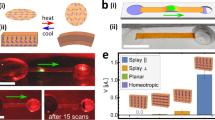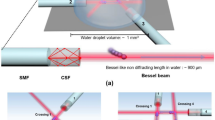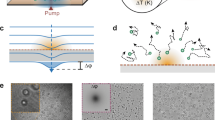Abstract
The reflection and refraction of light at a dielectric interface gives rise to forces due to changes in the photon momentum1. At the microscopic level, these forces are sufficient to trap and rotate microscopic objects2,3. Such forces may have a profound impact in the emergent area of microfluidics, where there is the desire to process minimal amounts of analyte. This places stringent criteria on the ability to pump, move and mix small volumes of fluid, which will require the use of micro-components and their controlled actuation4,5,6,7. We demonstrate the modelling, fabrication and rotation of microgears based on the principle of form birefringence. Using a geometric anisotropy (a one-dimensional photonic crystal etched into the microgear), we can fabricate microgears of known birefringence, which may be readily rotated by manipulating the input polarization in a standard optical trap. This methodology offers a new and powerful mechanism for generating a wide range of microfabricated machines, such as micropumps, that may be driven by purely optical control.
This is a preview of subscription content, access via your institution
Access options
Subscribe to this journal
Receive 12 print issues and online access
$259.00 per year
only $21.58 per issue
Buy this article
- Purchase on Springer Link
- Instant access to full article PDF
Prices may be subject to local taxes which are calculated during checkout




Similar content being viewed by others
References
Ashkin, A., Dziedzic, J. M., Bjorkholm, J. E. & Chu, S. Observation of a single-beam gradient force optical trap for dielectric particles. Optics Lett. 11, 288–290 (1986).
Paterson, L. et al. Controlled rotation of optically trapped microscopic particles. Science 292, 912–914 (2001).
Friese, M. E. J., Nieminen, T. A., Heckenberg, N. R. & Rubinsztein-Dunlop, H. Optical alignment and spinning of laser-trapped microscopic particles. Nature 394, 348–350 (1998).
Terray, A., Oakey, J. & Marr, D. W. M. Microfluidic control using colloidal devices. Science 296, 1841–1844 (2002).
Gauthier, R. C., Tait, R. N. & Ubriaco, M. Activation of microcomponents with light for micro-electro-mechanical systems and micro-optical-electro-mechanical systems applications. Appl. Optics 41, 2361–2367 (2002).
Friese, M. E. J., Rubinsztein-Dunlop, H., Gold, J., Hagberg, P. & Hanstorp, D. Optically driven micromachine elements. Appl. Phys. Lett. 78, 547–549 (2001).
Maruo, S., Ikuta, K. & Korogi, H. Force-controllable, optically driven micromachines fabricated by single-step two-photon micro stereolithography. J. Microelectromech. Syst. 12, 533–539 (2003).
Higurashi, E. et al. Optically induced rotation of anisotropic micro-objects fabricated by surface machining. Appl. Phys. Lett. 64, 2209–2210 (1994).
Higurashi, E., Ohguchi, O., Ukita, H. & Sawada, R. Optically induced rotation of disysymmetrically shaped fluorinated polyimide micro-objects in optical traps. J. Appl. Phys. 82, 2773–2779 (1997).
Galajda, P. & Ormos, P. Complex micromachines produced and driven by light. Appl. Phys. Lett. 78, 249–251 (2001).
Born, M. & Wolf, E. Principles of Optics 6th edn, Section 14.5.2 (Cambridge Univ. Press, Cambridge, 1980).
Bishop, A. I., Nieminen, T. A., Heckenberg, N. R. & Rubinsztein-Dunlop, H. Optical application and measurement of torque on microparticles of isotropic nonabsorbing material. Phys. Rev. A 68, 033802 (2003).
Nieminen, T. A., Heckenberg, N. R. & Rubinsztein-Dunlop, H. Optical measurement of microscopic torques. J. Mod. Optics 48, 405–413 (2001).
Acknowledgements
We thank the UK Engineering and Physical Sciences Research Council (EPSRC), the European Science Foundation SONS project NOMSAN and the European Commission 6th framework programme—NEST ADVENTURE Activity—through Project ATOM-3D (Contract No. 508952), for their support of this work. M. P. MacDonald acknowledges the support of an EPSRC Advanced Research Fellowship.
Author information
Authors and Affiliations
Corresponding author
Ethics declarations
Competing interests
The authors declare no competing financial interests.
Supplementary information
Supplementary Information
Movie S1 (MPG 7206 kb)
Supplementary Information
Movie S2 (MPG 4930 kb)
Supplementary Information
Movie S3 (MPG 4928 kb)
Supplementary Information
Supplementary figure S1 (PDF 264 kb)
Rights and permissions
About this article
Cite this article
Neale, S., MacDonald, M., Dholakia, K. et al. All-optical control of microfluidic components using form birefringence. Nature Mater 4, 530–533 (2005). https://doi.org/10.1038/nmat1411
Received:
Accepted:
Published:
Issue Date:
DOI: https://doi.org/10.1038/nmat1411
This article is cited by
-
Light-driven microdrones
Nature Nanotechnology (2022)
-
Reconfigurable multi-component micromachines driven by optoelectronic tweezers
Nature Communications (2021)
-
Microscopic metavehicles powered and steered by embedded optical metasurfaces
Nature Nanotechnology (2021)
-
Micro-scale opto-thermo-mechanical actuation in the dry adhesive regime
Light: Science & Applications (2021)
-
Spin to orbital light momentum conversion visualized by particle trajectory
Scientific Reports (2019)



